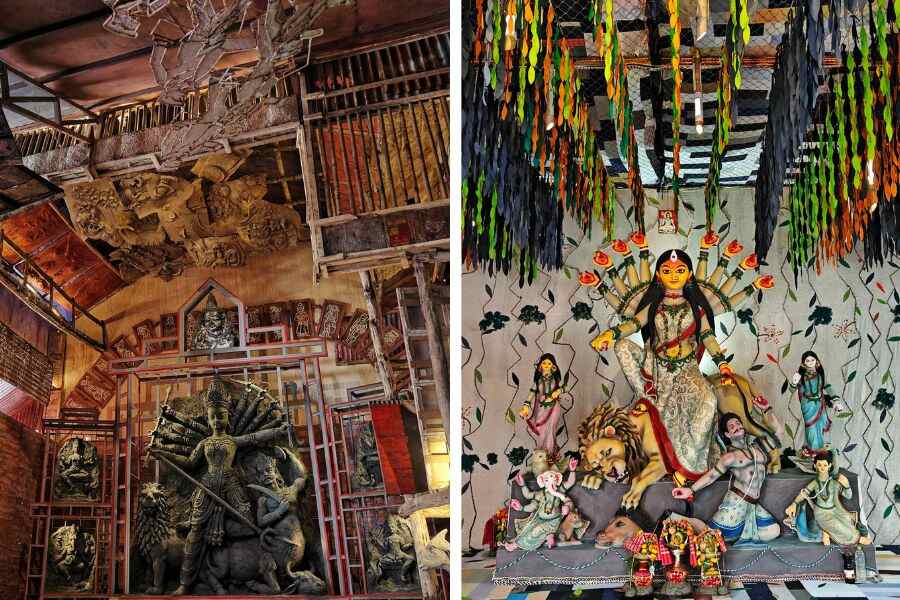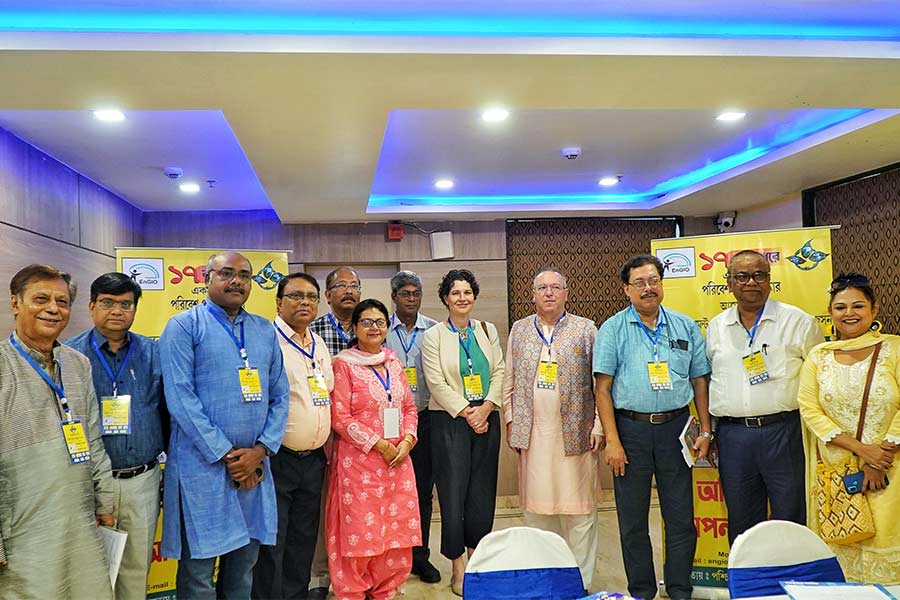Durga Puja is no doubt Bengal’s biggest festival, drawing millions to pandals across Kolkata and beyond, giving it immense potential to create a social impact. For the past 17 years, the Serader Sera Nirmal Puja Puroskar has been trying to channelise this potential towards the welfare of the environment. As the city soaked the celebratory spirit on Sashthi, the Green Awards 2024 entered its final leg.
“Climate change is going to determine the fate of our world. It needs to be seen as the biggest global issue. This isn't just an award but a movement,” said Jayanta Basu, director, Environment Governed Integrated Organisation (EnGIO).
The Green Puja Awards were instituted in 2007 and have since gained national and international prominence. Organised by EnGIO with My Kolkata, Serader Sera Nirmal Pujo Puroskar is supported by West Bengal government departments such as disaster management and the West Bengal Pollution Control Board. This year’s edition is sponsored by corporates like Exide, Vikram Solar, IndianOil, DBPL and Patton while Climate Action Network South Asia (CANSA) is the knowledge partner and The Plurals News Network being the knowledge partner. “When we started in 2007, only one puja in FD Block Salt Lake had an environmental theme. Today, one in every four pujas of Kolkata have an environmental theme,” Basu said.
The competition received 300 applications, of which 12 of the city’s greenest pujas were shortlisted as finalists. My Kolkata brings you a sneak peek from Day 2 of the final round, where 15 judges inspected six prominent pandals in the city.
Shibmandir Sarbojanin Durgotsab
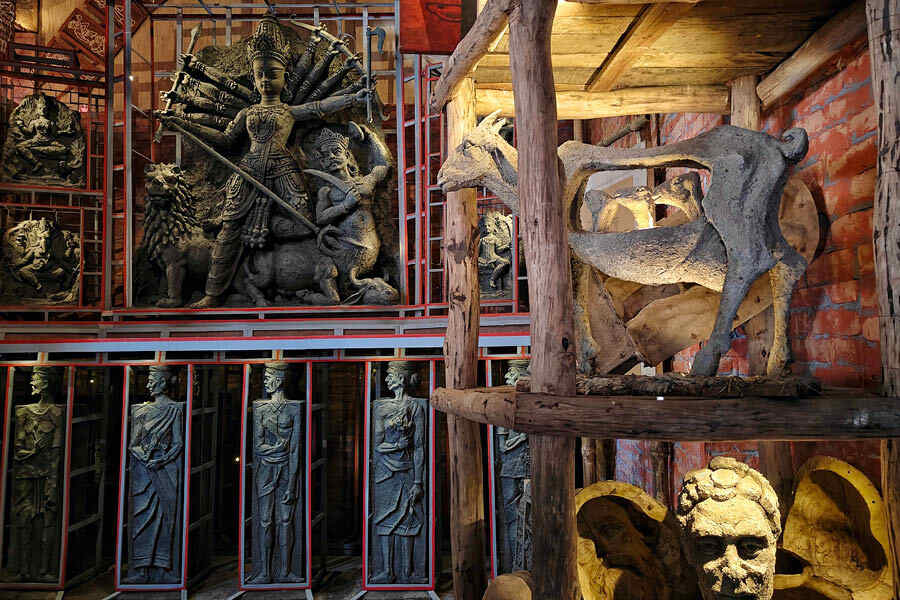
A hallmark of the protima at Shibmandir is no use of colours
There is a lot of effort that goes into every inch of the pandals that we visit and admire. The Durga puja at Shibmandir is a homage to all those faceless artists. “Labourers and artists work tirelessly for months to create these pandals but once completed, they themselves don’t get to enjoy the celebrations. We have tried to salute the work of these forgotten shilpis,” said Partho Ghosh, general secretary of the Shibmandir puja committee.
Apart from showcasing the various kinds of art from around Bengal, the puja demonstrates immense consciousness by exclusively using iron, which will be disassembled within a week and given to scrap dealers, clearing the road for use again. The idol is also made solely with mud, which apart from providing the authentic feeling of seeing the protima in a shilpi’s workstation, also prevents any harmful chemicals polluting the Ganga.
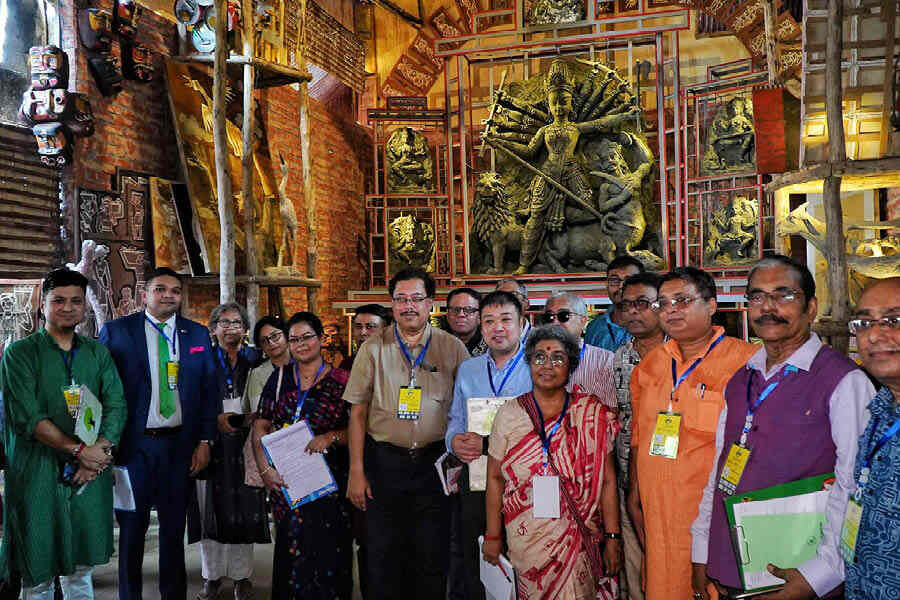
The jury lauded the puja committee’s drive to work for the betterment of the neighbourhood not just during the festive season, but throughout the year
What the judges said:
This puja has the assertion to ‘walk the talk’. Be it the use of biodegradable materials or recycling items from waste, they are setting an example on how to make Durga Puja sustainable.
— Ram Krishna Jaiswal, honorary consul, Republic of Maldives
Installing an idol without any colour significantly reduces pollution. Moreover, the use of iron sheets instead of bamboo makes the process of taking down the pandal seamless.
— Suktisita Bhattacharya, special commissioner of health department, Government of West Bengal
This pandal is a great motif for how Indians are very considerate about the impact of their actions on the environment. It is the first big pandal I have visited, and I see why Durga Puja is regarded as an intangible cultural heritage.
— Matsutaro Yamasaki, deputy consul general of Japan
Suruchi Sangha
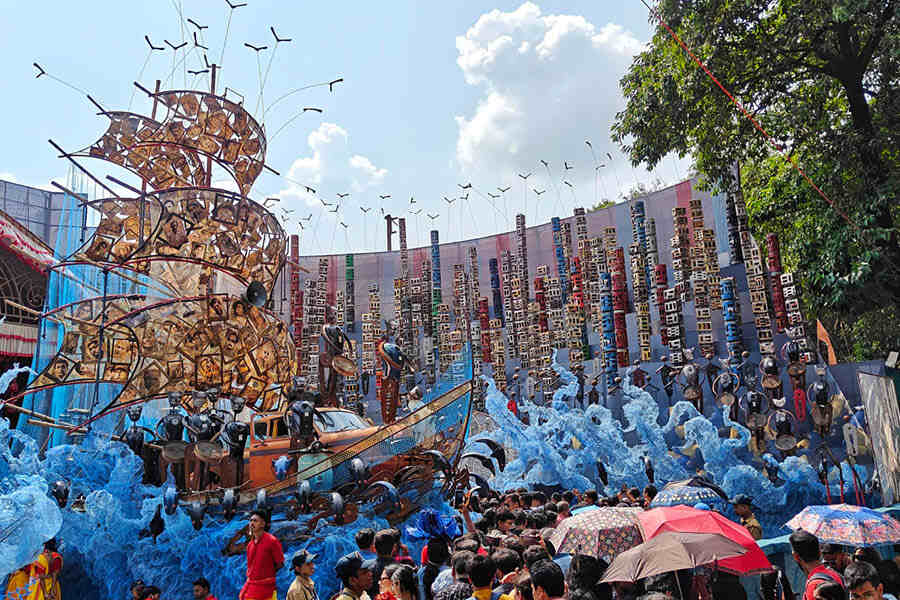
The pandal had blue waves emerging from tall skyscrapers, threatening to drown the roots under them, with a boat of nostalgic elements like the yellow taxi
This pandal decided to use the deep sense of nostalgia that Durga Puja evokes to remind people of their roots. Organising secretary Debshis Das explained, “Be it the yellow taxi, the tram, the gamchha, or our ageing parents, we are where we are because of our roots. However, rapid urbanisation is fast eroding them from our memory. Through our pandal, we wanted to beckon people to be more mindful of their roots while seeking development.”
One thing that stood out is how the idol has been made with mud, without any colours. In order to bring a contrast of colours, seven different types of mud was painstaking sourced from Santiniketan. The organisers are also committed to reusing the materials for Jagadhhatri Puja.
The pandal is expected to draw around five lakh people every day and gaps have been created in between the barricades for emergencies. Ambulance and oxygen are also available if needed. Forty-eight CCTV cameras are keeping a watchful eye.
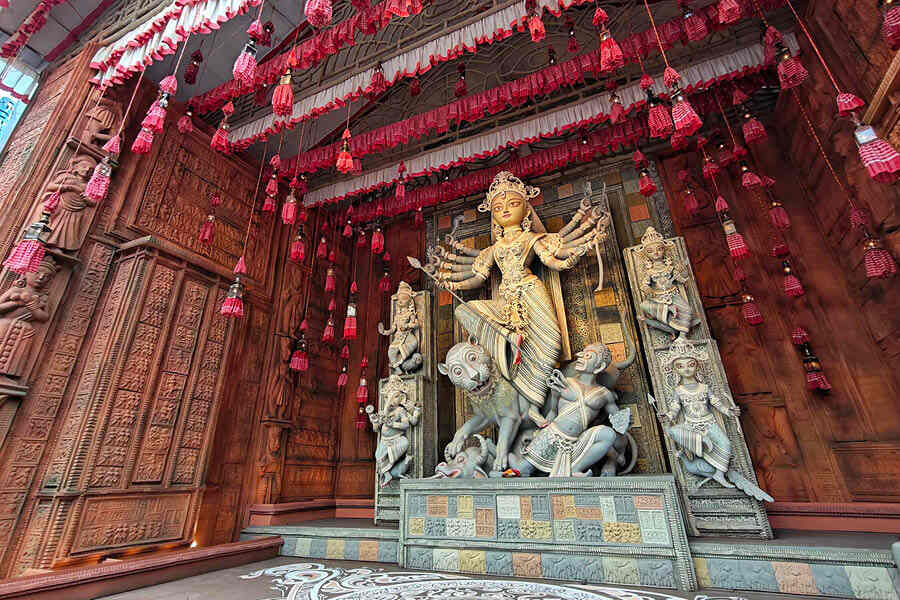
Another colour-less protima, the visual contrast was brought by the use of seven different types of mud
What the judges said:
It's admirable how they have sourced an idol without toxic colours and also incorporated a lot of clay into the decorations. The gamchha is another nice touch.
— Joyjeet Das, independent journalist
The theme about our roots really spoke to me. The commitment to safety with 40-plus CCTV cameras, spacious entry and exit points, and an on-call ambulance are admirable. I also like how they kept the noise level to a minimum.
— Morioum Begum Shorna, first secretary (political), Bangladesh Deputy High Commission
Golf Green Sarodotsava Committee
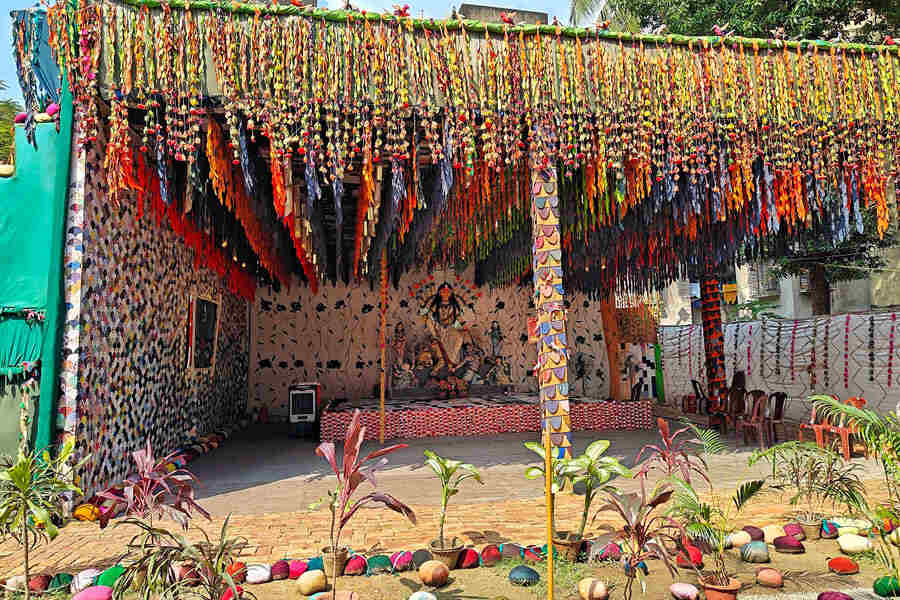
At this quintessential ‘para’r pujo’, over 800 families from the golf green locality donated unwanted clothes that were reused to decorate the pandal
Environmental responsibility doesn’t lie with the puja committee alone, but the neighbourhood as well. This unique puja perfectly demonstrates this, with the entire pandal made with recycled waste. “This pandal is a tribute to Ma Durga’s greatest gift: our planet Earth. We collected old and useless clothes from 800 families in the para over the past 10 months. More than 200 female artisans worked relentlessly to repurpose them by hand and decorate the pandal,” said chief artist Sujata Chatterjee.
To instil this message of recycling within the community, artists who worked on the pandal have been set up in a palanquin, where they demonstrate how they use waste clothing to create souvenirs. Even the depiction of a waterfall has been done by reusing rainwater!
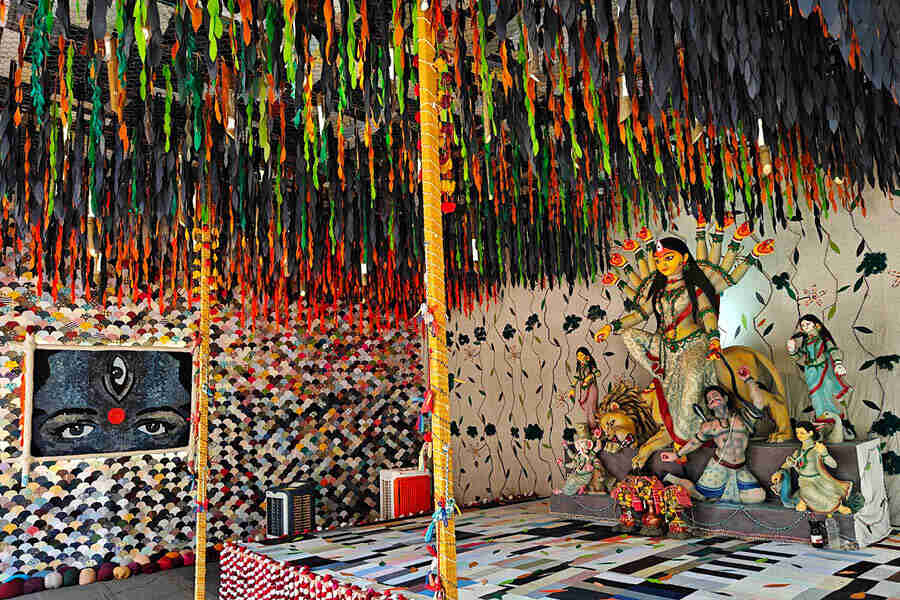
Over 200 women worked for almost four months to create the pandal
What the judges said:
Involving more than 200 women in the puja is commendable. The involvement of the local community preserves the true essence of Puja.
— Jitendra Kumar, president, legal and corporate affairs, Exide Industries Limited
Creating a fully recyclable pandal is a huge achievement. It's very inspiring to see their innovation, where using old fabrics has allowed them to not use any colours
— Krishnajyoti Goswami, director, NRCLPI
This pandal was not about creating a spectacle, but simplicity. Getting the community involved into recycling and upcycling is what stayed with me.
— Sujata Sen, CEO, Future Hope
Lalabagan Nabankur

The essence of the pandal was its greenery, with 8,000 plants adding to its appeal
A ‘green puja’ in the truest sense, this pandal features 8,000 plants, making visitors feel like they are in an immersive forest.
The puja committee spent the past year working with nurseries to nurture 59 varieties of plants, both indigenous and international. “We believe that trees must be nurtured like our own children. This is why we have created an ambience that reminds devotees of the value of nature,” said Rakesh Saha, assistant secretary. Their work has earned the puja the Regional Topper title in the North Kolkata zone.
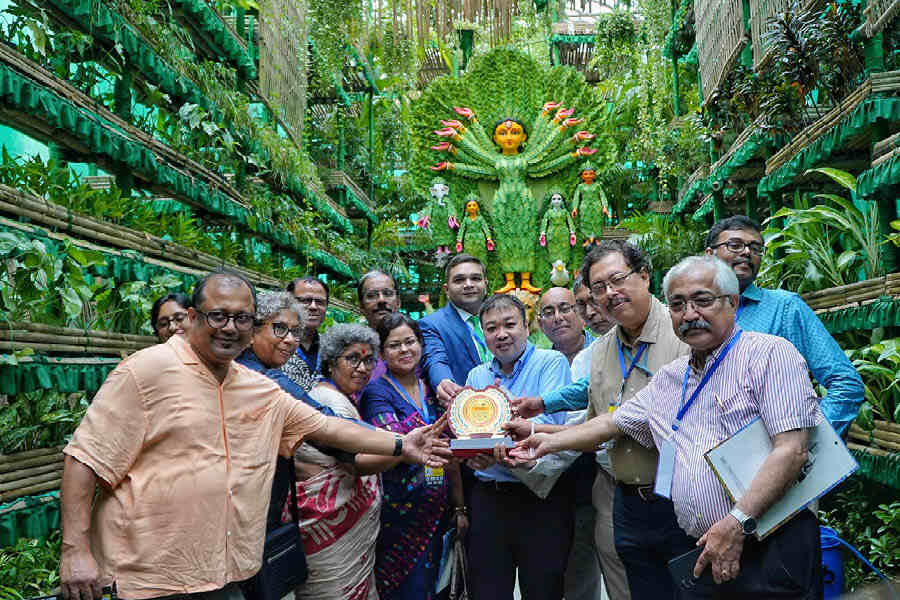
It’s environmental consciousness won Lalabagan the Regional Topper award from the North Kolkata zone
What the judges said:
Spending five months to nurture trees for a Durga Puja pandal is bound to have a greater impact on the entire neighbourhood. It’s heartening to see local clubs joining the movement, and we're hopeful that they will raise their voice when a tree in the para is cut down or a lake is polluted.
— Naba Dutta, general secretary, Sabuj Mancha
The theme focussed on the environment and the importance of preserving it. Their way of encouraging people to plant trees is a great way to combat climate change. It will help devotees imbibe a love for plants.
— Arunabha Majumder, ex-director-professor at All India Institute of Hygiene and Public Health
Dakshinpara Yuba Parishad

This pandal beckoned visitors to revisit the lifestyle of tribal communities, in order to understand how humans and nature can coexist
With the entire city complaining of unbearable summers, this pandal seems extremely fitting for the times we live in. “Deforestation has led to rising temperatures around the world. With climate change looming upon us, we feel that there is a lot to learn from Bengal’s tribal cultures, where people perfectly coexist with nature,” said the pandal’s art director, Arijit Amboli.
Apart from showcasing the arts and culture of Bengal’s tribal communities, this pandal has also celebrated the contributions of prominent environmentalists like Dukhu Majhi.
They have also taken several actionable steps such as extracting colours from flowers to be used in the pandal, and reducing the energy consumption to 4kw, from the 7kw that was used last year. These measures have crowned them as the Regional Toppers from Dum Dum.
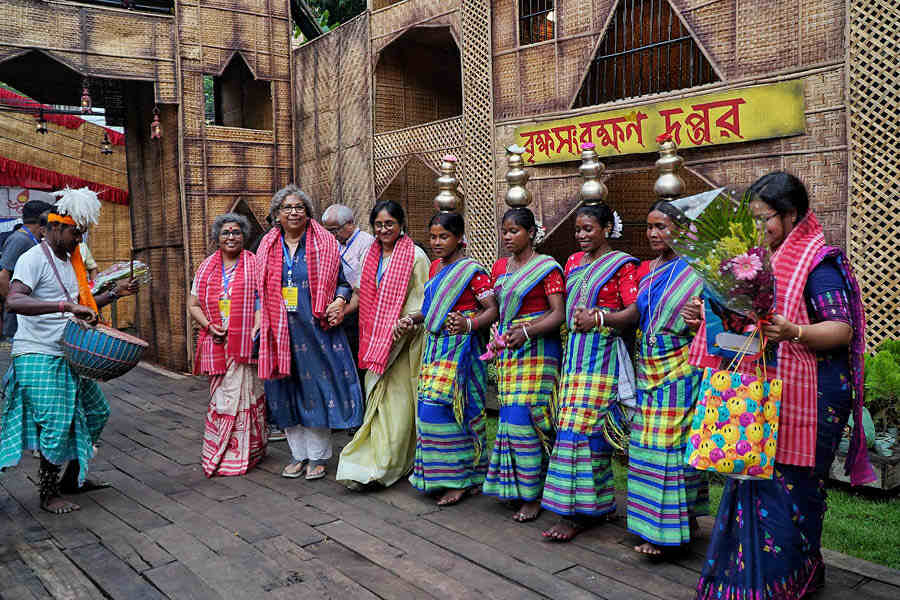
The jury enjoyed breaking a leg with some folk dancers from Birbhum
What the judges said:
This pandal can help inform visitors about the perils of deforestation and the resultant greenhouse effect.
— Ajoy Sarkar, clinical director, ICU, Peerless Hospital
The wall paintings in this pandal are especially interesting as they blend Indian mythology, art and nature to tell stories that reinforce environmental awareness.
— Matsutaro Yamasaki, deputy consul general of Japan
AK Block Association Salt Lake

The highlight of this pandal was a live demonstration of a rainwater harvesting system
Many believe that water will be the cause for a third World War. The grave circumstances surrounding the Earth’s most prized resource are the subject of this Durga puja pandal, which bagged the Regional Topper’s prize from the Salt Lake zone.
“The sea level is rising while groundwater is simultaneously decreasing. In this contentious time, we decided to showcase the power of rainwater harvesting,” said Sudipa Sarkar.
Made entirely with water and clay, the central focus of the pandal is a simulation of a rainwater harvesting setup, which brings about the rejuvenating feeling of rain through sounds. The walls have sketches depicting the various uses of the wonder liquid. The protima is another marvel, with recycled water being used for the anjali, and the goddess being symbolised through a girl holding her palms open, craving rain.
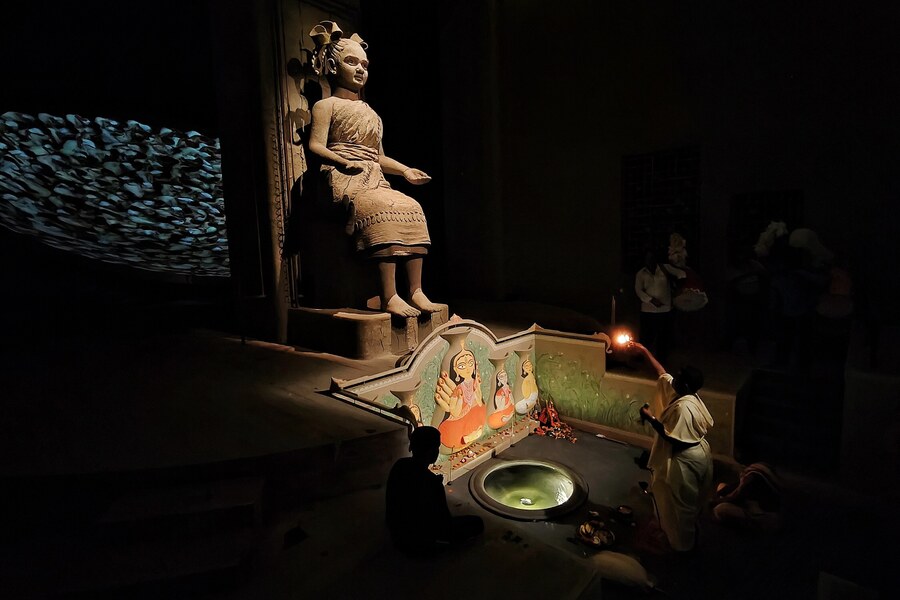
The weapon-less protima was personified by a girl seeking water, while recycled water was presented during the anjali
What the judges said:
This pandal will bring forth awareness about the tragic scarcity of water. Their aesthetics will hopefully appeal to the younger generation to join this cause.
— Arunabha Majumder, ex-director-professor at All India Institute of Hygiene and Public Health
Making a pandal with recycled water sends a powerful message. The multitude of solutions they have presented to the problem adds weight to their theme.
— Naba Dutta, general secretary, Sabuj Mancha
